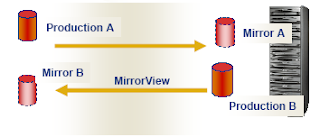MirrorView also known as MirrorView/S, because of its synchronous nature is a storage-based application that resides on the CLARiiON. It provides an online, host independent, mirrored data storage and protection solution that duplicates production site data (primary) to one or two secondary sites (secondary/secondaries) in a campus environment. The mirroring is synchronous, meaning that every time a host writes to the primary array, the secondary array mirrors the write before an acknowledgement is returned to the host. MirrorView ensures that there is an exact byte-for-byte copy at both the local CLARiiON and the remote CLARiiON. Since MirrorView is storage-based software, no host CPU cycles are used. This allows MirrorView to operate in the background, transparent to any hosts or applications, and to be able to provide the same information protection services to all server platforms and operating system that connect to the CLARiiON.
Salient Features:-
1) Independent of server, operating system, network, applications, and database.
2) Centralized, simplified management via EMC Navisphere.
3) Concurrent information access when used with SnapView.
4) Synchronous Remote Mirroring Between Two CLARiiON Systems.
MirrorView is fully integrated with EMC SnapView, the CLARiiON host-based software that creates consistent point-in-time copies for remote location snapshots. For simplified management and staff training, both MirrorView and SnapView are managed from within CLARiiON’s Navisphere Management software. That means that the same user-friendly Windows-like interface is common among all the CLARiiON software products, which minimizes learning curves and reduces training costs.The MirrorView software must be loaded on both arrays, regardless of whether the customer wants to implement bi-directional mirroring or not.
If only synchronous mirroring is required, then only MirrorView will need to be active on the local and remote CLARiiON(s). The secondary LUN must be the same size, though not necessarily the same RAID type, as the primary LUN. The Host cannot attach to an active secondary LUN as long as it is configured as a secondary mirror, unless you promote the secondary mirror to be the primary mirror (as seen in a disaster recovery scenario), or if you remove the secondary LUN as a secondary copy. Once this is done, a full resynchronization to the LUN would have to be performed.

No comments:
Post a Comment